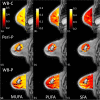Spatial heterogeneity of peri-tumoural lipid composition in postmenopausal patients with oestrogen receptor positive breast cancer
- PMID: 38409583
- PMCID: PMC10897464
- DOI: 10.1038/s41598-024-55458-y
Spatial heterogeneity of peri-tumoural lipid composition in postmenopausal patients with oestrogen receptor positive breast cancer
Erratum in
-
Author Correction: Spatial heterogeneity of peri-tumoural lipid composition in postmenopausal patients with oestrogen receptor positive breast cancer.Sci Rep. 2024 May 6;14(1):10332. doi: 10.1038/s41598-024-60477-w. Sci Rep. 2024. PMID: 38710712 Free PMC article. No abstract available.
Abstract
Deregulation of lipid composition in adipose tissue adjacent to breast tumour is observed in ex vivo and animal models. Novel non-invasive magnetic resonance imaging (MRI) allows rapid lipid mapping of the human whole breast. We set out to elucidate the spatial heterogeneity of peri-tumoural lipid composition in postmenopausal patients with oestrogen receptor positive (ER +) breast cancer. Thirteen participants (mean age, 62 ± [SD] 6 years) with ER + breast cancer and 13 age-matched postmenopausal healthy controls were scanned on MRI. The number of double bonds in triglycerides was computed from MRI images to derive lipid composition maps of monounsaturated, polyunsaturated, and saturated fatty acids (MUFA, PUFA, SFA). The spatial heterogeneity measures (mean, median, skewness, entropy and kurtosis) of lipid composition in the peri-tumoural region and the whole breast of participants and in the whole breast of controls were computed. The Ki-67 proliferative activity marker and CD163 antibody on tumour-associated macrophages were assessed histologically. Mann Whitney U or Wilcoxon tests and Spearman's coefficients were used to assess group differences and correlations, respectively. For comparison against the whole breast in participants, peri-tumoural MUFA had a lower mean (median (IQR), 0.40 (0.02), p < .001), lower median (0.42 (0.02), p < .001), a negative skewness with lower magnitude (- 1.65 (0.77), p = .001), higher entropy (4.35 (0.64), p = .007) and lower kurtosis (5.13 (3.99), p = .001). Peri-tumoural PUFA had a lower mean (p < .001), lower median (p < .001), a positive skewness with higher magnitude (p = .005) and lower entropy (p = .002). Peri-tumoural SFA had a higher mean (p < .001), higher median (p < .001), a positive skewness with lower magnitude (p < .001) and lower entropy (p = .012). For comparison against the whole breast in controls, peri-tumoural MUFA had a negative skewness with lower magnitude (p = .01) and lower kurtosis (p = .009), however there was no difference in PUFA or SFA. CD163 moderately correlated with peri-tumoural MUFA skewness (rs = - .64), PUFA entropy (rs = .63) and SFA skewness (rs = .59). There was a lower MUFA and PUFA while a higher SFA, and a higher heterogeneity of MUFA while a lower heterogeneity of PUFA and SFA, in the peri-tumoural region in comparison with the whole breast tissue. The degree of lipid deregulation was associated with inflammation as indicated by CD163 antibody on macrophages, serving as potential marker for early diagnosis and response to therapy.
Keywords: Breast cancer; Heterogeneity; Inflammation; Lipid composition; Oestrogen receptor.
© 2024. The Author(s).
Conflict of interest statement
The authors declare no competing interests.
Figures




Similar articles
-
Differentiation of histological calcification classifications in breast cancer using ultrashort echo time and chemical shift-encoded imaging MRI.Front Oncol. 2024 Dec 17;14:1475090. doi: 10.3389/fonc.2024.1475090. eCollection 2024. Front Oncol. 2024. PMID: 39741975 Free PMC article.
-
Peri-tumoural spatial distribution of lipid composition and tubule formation in breast cancer.BMC Cancer. 2022 Mar 17;22(1):285. doi: 10.1186/s12885-022-09362-1. BMC Cancer. 2022. PMID: 35300617 Free PMC article.
-
Intra-tumoural lipid composition and lymphovascular invasion in breast cancer via non-invasive magnetic resonance spectroscopy.Eur Radiol. 2021 Jun;31(6):3703-3711. doi: 10.1007/s00330-020-07502-4. Epub 2020 Dec 3. Eur Radiol. 2021. PMID: 33270144 Free PMC article.
-
Impact of saturated compared with unsaturated dietary fat on insulin sensitivity, pancreatic β-cell function and glucose tolerance: a systematic review and meta-analysis of randomized, controlled trials.Am J Clin Nutr. 2023 Oct;118(4):739-753. doi: 10.1016/j.ajcnut.2023.07.018. Epub 2023 Jul 25. Am J Clin Nutr. 2023. PMID: 37500058
-
Current Evidence Supporting the Link Between Dietary Fatty Acids and Cardiovascular Disease.Lipids. 2016 May;51(5):507-17. doi: 10.1007/s11745-015-4113-x. Epub 2015 Dec 30. Lipids. 2016. PMID: 26719191 Review.
Cited by
-
Differentiation of histological calcification classifications in breast cancer using ultrashort echo time and chemical shift-encoded imaging MRI.Front Oncol. 2024 Dec 17;14:1475090. doi: 10.3389/fonc.2024.1475090. eCollection 2024. Front Oncol. 2024. PMID: 39741975 Free PMC article.
-
Peri-Tumoural Lipid Composition and Hypoxia for Early Immune Response to Neoadjuvant Chemotherapy in Breast Cancer.Int J Mol Sci. 2024 Aug 28;25(17):9303. doi: 10.3390/ijms25179303. Int J Mol Sci. 2024. PMID: 39273252 Free PMC article.
References
-
- Lifetime risk estimates calculated by the statistical information team at Cancer Research UK, based on Office for National Statistics (ONS) 2016 life expectancies and population projections. CRUK, accessed 14 Feb 2024) https://www.cancerresearchuk.org/health-professional/cancer-statistics/r... (2023).
-
- Early Breast Cancer Trialists' Collaborative Group (EBCTCG) et al. Relevance of breast cancer hormone receptors and other factors to the efficacy of adjuvant tamoxifen: Patient-level meta-analysis of randomised trials. Lancet. 2011;378(9793):771–84. doi: 10.1016/S0140-6736(11)60993-8. - DOI - PMC - PubMed
MeSH terms
Substances
Grants and funding
LinkOut - more resources
Full Text Sources
Medical
Research Materials

